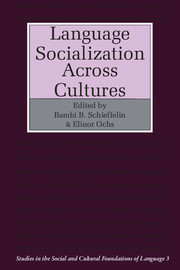Book contents
- Frontmatter
- Contents
- List of contributors
- 1 Introduction
- Part I Acquiring language and culture through interactional routines
- Part II Acquiring knowledge of status and role through language use
- Part III Expressing affect: input and acquisition
- 8 Teasing and shaming in Kaluli children's interactions
- 9 Teasing: verbal play in two Mexicano homes
- 10 Teasing as language socialization and verbal play in a white working-class community
- 11 The acquisition of communicative style in Japanese
- 12 From feelings to grammar: a Samoan case study
- Index
11 - The acquisition of communicative style in Japanese
Published online by Cambridge University Press: 05 June 2012
- Frontmatter
- Contents
- List of contributors
- 1 Introduction
- Part I Acquiring language and culture through interactional routines
- Part II Acquiring knowledge of status and role through language use
- Part III Expressing affect: input and acquisition
- 8 Teasing and shaming in Kaluli children's interactions
- 9 Teasing: verbal play in two Mexicano homes
- 10 Teasing as language socialization and verbal play in a white working-class community
- 11 The acquisition of communicative style in Japanese
- 12 From feelings to grammar: a Samoan case study
- Index
Summary
One of the most striking meeting places of language and culture can be found in communicative style. The notion of communicative style has been defined by Barnlund (1975) to include the topics people discuss, their favorite forms of interaction, the depth of involvement sought, the extent to which they rely upon the same channels for conveying information, and the extent to which they are tuned to the same level of meaning, such as factual versus emotional content. Obviously, communicative style is one aspect of “communicative competence,” relating, in particular, to the “rules for use” that govern speakers' production and interpretation of language appropriately in context (Hymes 1972). Communicative style, which I will define loosely here as the way language is used and understood in a particular culture, both reflects and reinforces fundamental cultural beliefs about the way people are and the nature of interpersonal communication. As Scollon (1982) has argued, children's acquisition of culture-specific patterns of communication is an extremely important part of their socialization, since such patterns serve as one of the primary sources of information on cultural values concerning social relationships and interaction. Thus acquisition of communicative style plays a part in the development of children's social cognition, thereby helping to shape their world view (Whorf 1956) or “reality set” (Scollon & Scollon 1981).
Japanese communicative style
It is widely recognized that the communicative style of the Japanese is intuitive and indirect, especially compared with that of Americans.
- Type
- Chapter
- Information
- Language Socialization across Cultures , pp. 213 - 250Publisher: Cambridge University PressPrint publication year: 1987
- 41
- Cited by

